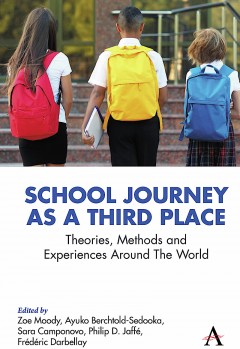School Journey as a Third Place
Theories, Methods and Experiences Around The World
Edited by Zoe Moody
Ayuko Berchtold-Sedooka
Sara Camponovo
Philip D. Jaffé
Frédéric Darbellay
Other Formats Available:
- About This Book
- Reviews
- Author Information
- Series
- Table of Contents
- Links
- Podcasts
About This Book
Journeys to school are important time and space transitions between homes and schools for children worldwide. This book comprises various chapters providing insights into children’s experiences of this essential aspect of their lives and schooling experience. From an interdisciplinary and intercultural perspective, leading international scholars focus on how children from very different contexts travel between their homes and their schools and how this transitional space impacts their daily lives and interactions with their environment. An overview of different school journeys is covered, laying out the contours of a child-friendly and context-responsive transition to and from school.
The way to and from school becomes a third place for some children who develop meaningful social and environmental relationships, mix up with children who belong to different groups, learn, relax, and so on. As genuine social actors, children invest one of the last spaces of freedom they are given to apprehend their environment. What is specific to this almost universal experience, and what varies depending on various individuals or contexts? How do children themselves act, impact and appreciate the journey to and from school?
Various studies from a wide range of disciplines and using different methods have highlighted benefits and risks related to children’s journey to school, providing insightful data regarding modes of transportation, health and wellbeing issues, school organisation and legislation, safety or urban development and so on. Research has also shown how this journey can support positive links between the child and his or her social and natural environment. Realities, however, vary immensely depending on the context. Some children accompanied to school by adults barely have the opportunity to interact with their environment or benefit from some welcome physical activity after sitting for several hours in class. Conversely, others walk long distances or even face relatively serious hazards during their journey.
Reviews
“The book’s multidisciplinary approach in studying children’s school journeys around the world produces rich and exciting new knowledge on children’s autonomous mobility whilst also attesting to the multidimensionality of their lives within this everyday transitional space of theirs” —Leena Alanen, Professor Emerita (Early Childhood Education), Department of Education, Associate Professor/Docent (Sociology), Department of Social Sciences and Philosophy, University of Jyväskylä, Finland.
“This book provides a theoretically and empirically nuanced exploration of the school journey that the contributors highlight with carefully crafted analyses through children’s own voices and experiences. Exploring the school journey as a transitional or third space, the book greatly enriches our understanding of a key but often neglected aspect of children’s daily lives and well-being” —Spyros Spyrou, Professor of Anthropology, European University Cyprus.
“School Journey as a Third Place; Theories, Methods, and Experiences around the World” is a book focusing on the topic of the journey of children between home and school. The book underlines that the way between school and home can be perceived as the “third place”, as a transition space, potentially having an impact on the children’s experience, well-being, feelings, and development. The book also presents the impact of spatial design, safety, disability, and parents’ fears on the choice of the mode of travel and the experiences of children. The authors focus on the social, cultural, psychological, and educational aspects of being in the third place. They argue that the way between home and school can be a space, where children find their independency and create relationships with the environment. Sometimes it can be a positive experience, enriching the growth of the child, however, it can also be a space of fear and danger.—Katarzyna Soszyńska, Language, Discourse & Society, vol. 11, no. 1(21), 2023.
Author Information
Zoe Moody is Professor at the University of Teacher Education Valais and Senior Research Associate at the Centre for Children’s Rights Studies, University of Geneva.
Ayuko Berchtold-Sedooka, PhD, is Research Associate at the Centre for Children’s Rights Studies, University of Geneva, and Expert in educational resource production, at éducation21.
Sara Camponovo, PhD, is Research Associate at the Centre for Children’s Rights Studies, University of Geneva.
Philip D. Jaffé is Professor at the Centre for Children’s Rights Studies, University of Geneva,
and a member of the UN Committee on the Rights of the Child.
Frédéric Darbellay is Associate Professor at the University of Geneva and Head of the Inter- & Transdisciplinarity Unit at the Centre for Children’s Rights Studies.
Series
Anthem Series on Thresholds and Transformations
Table of Contents
Introduction; Part I. Theories And Methods to Explore the School Journey, Chapter 1. The Multidimensionality of the Way to and from School: A Third Place for Children?; Chapter 2. Walking through Mundane Landscapes: Children’s Experience of Place during the School Journey; Chapter 3. Dangers in the Third Place: Walking, Public Transport and the Experiences of Young Girls in Cape Town and Abuja; Chapter 4. The (Im)Possibility of Spatial Autonomy for Young City Dwellers; Chapter 5. The Quality of the Way to School Lies in the Design Details; Part II. Children’s Experiences of The School Journey Chapter 6. Children’s Experiences and Affective Connections with Place in Their Independent Mobility; Chapter 7. Parental Concerns and Perceptions Related to Children’s Independent Travel to School: A Case Study in Germany; Chapter 8. How Does Families’ Daily Mobility between Home and School Change with the Trottibus, a Walking School Bus Program in Quebec, Canada?; Chapter 9. The Spatial Distribution of the Walking School Bus: An Interactionist Approach; Chapter 10. Incorporating the Extended Theory of Planned Behaviour in a School Travel Mode Choice Model: A Case Study of Shaoxing; Chapter 11. Thinking about Ableism and Third Place to Understand and Improve the School Journeys of Disabled Children and Their Families; Index
Links
Stay Updated
Information
Latest Tweets



